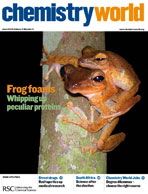Research activities in this multidisciplinary group concentrate on the energetics and mechanism of fundamental processes in biological macromolecules and living systems, utilising sensitive biophysical instrumentation coupled with advanced molecular biology techniques. Much of this work is in close collaboration with colleagues from other disciplines. Topics include:
Froth, Foam and Bubble: The biophysical chemistry and potential applications of foamy biological secretions. A Sir Henry Wellcome Commemorative project in collaboration with Malcolm Kennedy, also funded in part by BBSRC, allowed us to initiate studies into the macromolecular structure and properties of foam nests of tropical frogs. This has led to discoveries of new surfactant proteins and lectins (ranaspumins), and a new indophenol-like chromophore/crosslink in a blue protein, ranasmurfin, from the foam nests of a Malaysian tree frog.
For an overview, see the nice article by Michael Gross in the June 2009 edition of Chemistry World … or listen to the Chemistry World podcast – starting at about 7min.
Together with Brian Smith in Glasgow, we have now extended this work on natural surfactant proteins to include the structure and function of latherin from horse sweat and saliva.
Protein Dynamics and Thermodynamics: Early work on the fundamental link between thermodynamics and inevitable thermal fluctuations in small systems underpins our current understanding of the conformational dynamics of protein structures and other macromolecules. This has led to new ways of explaining cooperativity and allosteric effects in biomolecular systems. Dynamic allostery is now gaining considerable experimental support.
Protein Folding, Misfolding, and Aggregation: Studies on the energetics and mechanism of protein folding, misfolding and aggregation using sensitive differential scanning calorimetry (DSC, PPC) and related biophysical techniques.
Fundamentals of Biomolecular Forces: Experimental and theoretical investigation of the physical basis of non-covalent forces in biomolecules, using microcalorimetry, pressure perturbation calorimetry, isotope substitution and other methods. Thermodynamics of hydrogen-bonded lattices.
Microcalorimetry: This laboratory served for many years as the UK Biological Microcalorimetry Facility, equipped with Microcal VP-DSC, VP-ITC, and PPC instruments available to external users in addition to our own projects.
Parasitic Nematode Proteins: Structure and function investigations of a major family of allergenic proteins from parasitic worms with important fatty acid and retinoid binding properties, using NMR, fluorescence probes and other biophysical methods (in collaboration with Malcolm Kennedy and Brian Smith).
Protein-Protein and Protein-Nucleic Acid Interactions: Determination of the thermodynamics of important interactions between biological macromolecules, including microcalorimetry of DNA-repressor, RNA-viral capsid, multi-enzyme subunit and cell surface protein complexes.
Protein-Cyclodextrin Interactions: The effects of cyclodextrins on the stability of folded proteins and protein-protein interactions, including possible roles as “chaperone mimics” in the control of protein folding.
Molecular Recognition in Peptide Antibiotics: Measurement of the interaction forces responsible for receptor binding and ligand-induced intermolecular associations in vancomycin and related peptide antibiotics, using isothermal titration microcalorimetry (ITC) and spectroscopic methods.
Grant support: BBSRC, EPSRC, Wellcome Trust, SKB, Pfizer, GlaxoWellcome, and others.
